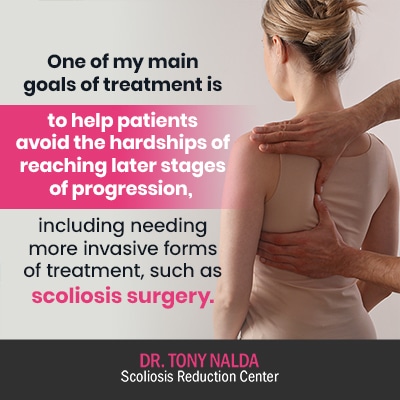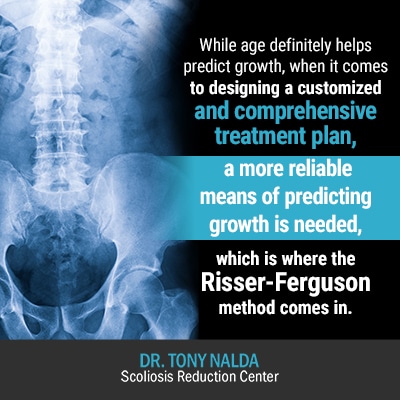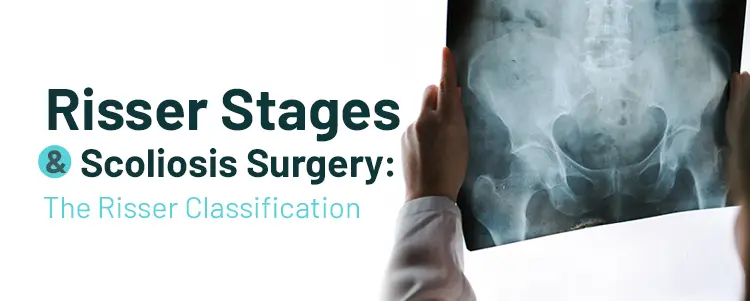As a progressive and incurable condition, one of the biggest challenges to treating scoliosis is managing a patient’s progression, and there is no definitive means by which I can predict, with one-hundred percent accuracy, a patient’s rate of progression. However, there are important patient and condition characteristics that can help me predict a patient’s likeliest rate of progression. Keep reading to find out how the Risser-Ferguson method can help.
Growth is the big trigger for scoliosis progression, and determining how much growth a patient has left can help identify a patient’s rate of progression. The Risser-Ferguson method uses a classification system to assign stages of ossification (bone tissue formation) to overall skeletal development.
Before we discuss the specifics of the Risser-Ferguson method and the process of assigning Risser stages to levels of skeletal maturity, let’s first address the characteristics of scoliosis that makes these types of methods an important part of assessment and treatment.
Scoliosis and Progression
‘Progression’ is a medical term that means a condition’s nature is to get worse over time, especially if left untreated, or not treated appropriately.
With progressive and incurable conditions, determining a patient’s rate of progression is an important aspect of managing the condition. Staying ahead of a patient’s progressive line means working to keep a condition from getting worse and producing more adverse symptoms.
In the context of scoliosis, we’re talking about a spinal condition that involves having an abnormal sideways curvature of the spine, that also rotates, and this disrupts the spine’s biomechanics.
As scoliosis progresses, this means the abnormal curvature is getting larger, and this also tends to mean that related symptoms such as postural changes and pain (more common in adults) also become more severe.
Scoliosis develops across a large severity spectrum, meaning every case is different and can range from mild to moderate, and severe to very severe.
The gold standard for assessing how severe a patient’s condition is is known as Cobb angle, and this is a measurement obtained via X-ray that tells me how far out of a natural and healthy alignment a scoliotic spine is:
- Mild scoliosis: Cobb angle measurement of between 10 and 25 degrees
- Moderate scoliosis: Cobb angle measurement of between 25 and 40 degrees
- Severe scoliosis: Cobb angle measurement of 40+ degrees
- Very-severe scoliosis: Cobb angle measurement of 80+ degrees
This is an important piece of information because as part of the diagnostic process, a condition has to be further assessed and classified so we can craft the most effective treatment plan possible.

One of my main goals of treatment is to help patients avoid the hardships of reaching later stages of progression, including needing more invasive forms of treatment, such as scoliosis surgery.
There are different forms of scoliosis that can develop both with known and unknown causes; as the most prevalent form of scoliosis is adolescent idiopathic scoliosis (AIS), diagnosed between the ages of 10 and 18, let’s focus on how the condition affects this age group.
Growth and Progression
As mentioned, managing progression is a huge part of designing an effective treatment plan, and part of that is using different patient and condition characteristics to help predict a patient’s likeliest rate of progression.
While we don’t know how fast, or slowly, a patient’s condition is going to progress, we do know that as it’s progressive, at some point, scoliotic curves are virtually guaranteed to get worse.
The most important patient characteristic for predicting progression is age and growth. As we know that growth is the number-one trigger for scoliosis progression, we know that the more growth a patient has yet to go through, the more likely it is that their condition is going to progress.
As adolescents are in, or entering into, the stage of puberty with rapid and unpredictable growth spurts, we know that predicting how much growth a patient has yet to go through is an indicator for their likeliest progressive rate.
While age definitely helps predict growth, when it comes to designing a customized and comprehensive treatment plan, a more reliable means of predicting growth is needed, which is where the Risser-Ferguson method comes in.
Risser-Ferguson Method
As mentioned, Cobb angle is the gold standard for assessing a patient’s scoliosis in terms of severity; in terms of growth and potential progression, the Risser-Ferguson method can also help with determining how much growth is left prior to a patient reaching skeletal maturity.
While adults who have reached skeletal maturity can still experience progression, in typical cases of adult idiopathic scoliosis, the rates tend to slow once the big trigger of growth is removed.
The Risser-Ferguson method involves assigning stages from 0 to 5 to the process of ossification and attachment of sections of the pelvis, known as the iliac apophysis. Ossification is the process of bone tissue formation.

The higher the stage of ossification, the closer a patient is to reaching skeletal maturity; the lower the stage of ossification, the more growth a patient has yet to go through before reaching skeletal maturity.
This information is important because it helps me predict just how much progression, and at what rate, has to be addressed in order to treat the condition proactively and effectively.
This is part of the reason that a fully-customized treatment approach is needed for each and every patient: because each and every patient has their own rate of growth and related progression.
Having the most information available means being able to craft a course of treatment with the highest potential for a successful outcome, and a patient’s Cobb angle and Risser stage provide patient and condition characteristics that are crucial aspects of designing a comprehensive treatment plan.
So for a patient who has a ‘0’ Risser stage classification, this means they are far from reaching skeletal maturity and could experience a lot of progression as they grow towards maturity; a patient with a ‘5’ Risser stage classification has reached, or is close to reaching, skeletal maturity, and this means that they are less likely to experience rapid-phase progression.
As mentioned earlier, one of my treatment goals, here at the Scoliosis Reduction Center®, is to help patients manage their scoliosis without scoliosis surgery, as I feel this gives them the best possible quality of life by preserving the spine’s overall health and function.
So now that we have addressed some important patient and condition characteristics, particularly in relation to growth and progression, plus how the Risser stages help rate a patient’s level of skeletal maturity, let’s talk about how these characteristics can lead to surgery, for those following the traditional approach.
Treatment Approach and Spinal-Fusion Surgery
Fortunately, there are more scoliosis treatment options available now than there were in the past. While the traditional approach is still relied on, a more functional chiropractic-centered approach has emerged over the years and gained in popularity due to its measurable treatment results.
The functional chiropractic-centered approach that I rely on here at the Center offers patients a very different potential outcome. It’s crucial that patients, and their families, understand that different treatment approaches have different end goals in mind, and reaching these end goals by different means produces different results.
As I’ve stated throughout the article, part of my end goal is to help patients avoid further progression and spinal-fusion surgery, and you might be wondering why.
Spinal-Fusion Surgery
To me, spinal fusion is not always a patient’s best choice, and for those that choose to forego a scoliosis-surgery recommendation, they most certainly have another choice.
Those following the traditional treatment approach are often funneled towards spinal fusion because proactively treating the condition early on is not part of the approach.
As mentioned, scoliosis can range from mild to moderate, severe and very severe. For mild cases, the traditional approach most often recommends monitoring at predetermined intervals, often telling patients to return every 3-to-6 months (varies depending on the doctor) for X-rays to see if a condition has progressed.
My problem with this is that we already know scoliosis is progressive, so we know it’s going to progress at some point.
What the traditional approach does is passively observe a condition while it’s mild, recommend traditional bracing with continued progression into the moderate stage, and once it progresses into the severe stage and crosses that surgical-level threshold, spinal-fusion surgery is commonly recommended as the best means of preventing further progression; however, spinal fusion is not guaranteed to control progression, as there are never treatment guarantees, and can come at a heavy price.
What might have happened if that same mild condition was treated proactively early on so that it didn’t have the chance to progress unimpeded? The measurable results that I have seen with patients of the Center support that early detection is highly beneficial in terms of treatment success, and even cases diagnosed later in the progressive line can be treated proactively by reducing the curvature and increasing core strength so the spine is better supported and stabilized.
For those following the traditional approach, Risser classification is also used to help assess conditions and determine how much likely progression, related to growth, a patient has yet to go through.
As the goal of scoliosis surgery is to stop progression by fusing the most-tilted vertebrae of the abnormal curvature into one solid bone to eliminate movement, a patient’s low Risser score indicating a lot of remaining growth and related potential progression, can be further reasoning behind a scoliosis-surgery recommendation under the traditional approach.
However, the way scoliosis surgery reaches its end goal of stopping progression can carry some heavy potential side effects and risk of complications; in addition, the loss of movement in the fused area of the spine can place limitations on the spine’s function and patients’ spinal flexibility.
Undergoing scoliosis surgery is a decision that should not be taken lightly because its results are permanent. There is no unfusing a fused spine, and some patients are disappointed with the results.
More information about the process and potential effects of spinal fusion can be found here.
Conclusion
As a scoliosis chiropractor, I rely on multiple methods for diagnosing, assessing, and treating scoliosis.
As the nature of scoliosis necessitates a customized treatment approach, using only one method will fall short when it comes to designing a comprehensive treatment plan moving forward.
Relying on multiple screening, diagnostic, assessment, and treatment methods such as physical exams, X-rays when needed, Cobb angle, and the Risser classification system allows me to craft a more patient-specific treatment plan, and this carries more potential for successful results.
For those following a traditional approach, the information provided by these methods can be used to further funnel patients towards scoliosis surgery, particularly for those patients with a low Risser score who are more likely to progress due to growth.
As patients who are further away from reaching skeletal maturity are more likely to progress and stopping progression is the main goal of scoliosis surgery, rather than working proactively to reduce the curvature early on, the traditional approach includes passively observing for progression and attempting traditional bracing, until a condition passes that surgical-level threshold.
Here at the Scoliosis Reduction Center®, I work proactively to achieve a curvature reduction and provide the spine with better support and stabilization through increased core strength; I achieve these results by combining multiple scoliosis-specific treatment disciplines such as chiropractic care, in-office therapy, custom-prescribed home exercises, and specialized corrective bracing.
Thanks to patient-specific information provided by measurements and methods such as Cobb angle and the Risser classification, I can design comprehensive patient-specific treatment plans.





